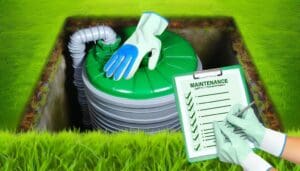Discover how to protect your septic system from breakdown with...
Read MoreYou & Your Septic Tank
The Dirty Truth About Septic Tanks: Myths And Misconceptions Debunked
Our professional septic service team offers comprehensive septic tank pumping services to keep your system running smoothly. Get a FREE Quote Today.

The Dirty Truth About Septic Tanks: Myths And Misconceptions Debunked
I’ve heard it all before – the whispers, the misconceptions and even some outright horror stories. As a septic tank expert with years of experience under my belt, I can’t help but cringe when people fall prey to myths that are just not true.
It’s time to put these tales to rest once and for all, so you can finally feel liberated knowing the dirty truth about septic tanks. In this article, we’ll debunk common myths surrounding septic tanks and give you peace of mind by uncovering the real facts behind them.
No more worrying about whether your system is on the verge of disaster or if those ‘secrets’ you’ve been told are actually worth following. Together, let’s dive into the world of septic systems and embrace our newfound freedom from misinformation!
What Is A Septic Tank?
A septic tank is like a hidden underground ecosystem, teeming with life and constantly processing waste to keep our homes clean and safe. As a septic tank specialist, I’ve seen the fascinating world of septic biology in action, breaking down household waste into harmless substances that are eventually released back into the environment.
Many people don’t realize just how intricate these tank systems can be – they’re not simply holes in the ground filled with sewage. No, my friends, they are carefully engineered structures designed to manage wastewater efficiently and sustainably.
Now that we have a basic understanding of what a septic tank is, it’s important for us to dive deeper into this captivating subject (pun intended!). The more you learn about how these ingenious systems work, the less mysterious and intimidating they become.
Knowing the ins and outs of your own septic system can lead to an empowering sense of liberation as you take control over maintaining its health and efficiency. So let’s continue our journey by exploring the mechanics behind these marvels of engineering – prepare to be amazed at how do septic tanks work!
How Do Septic Tanks Work?
Hey there, I’m a septic tank expert and I’m here to help you understand how septic tanks work. Let’s start with the basics – a septic tank is a self-contained, underground wastewater treatment system that holds and processes wastewater from a home or business. Then, we’ll get into the components of a septic system, including the tank, piping, and drainfield. Finally, we’ll look into the wastewater treatment processes that take place inside the tank. So, let’s get started!
Septic Tank Basics
Isn’t it time we all stopped being so squeamish about septic tanks and faced the dirty truth head on?
As a septic tank expert, I can tell you there’s nothing to fear; in fact, understanding your home’s septic design is pretty darn liberating.
You see, when properly maintained, these underground systems provide an efficient way of managing household wastewater through natural processes.
It starts with the tank installation – that big concrete or plastic container buried beneath your yard – where solid waste settles at the bottom while liquids flow out into a drain field for further treatment by soil organisms.
So next time someone tries to gross you out with ‘septic talk,’ just remember how incredibly resourceful this system really is!
Septic System Components
Now that we’ve faced the dirty truth head on, let’s dive a little deeper into what makes these systems tick by exploring septic system components.
As your friendly neighborhood septic tank expert, I’m here to guide you through this liberating journey of understanding how everything works together in perfect harmony.
The heart and soul of any septic system is the Septic Drainfield, which provides an essential space for liquid waste treatment as it filters through various layers of soil teeming with beneficial bacteria.
Speaking of bacteria levels – they play a significant role in breaking down solid wastes within the tank itself, ensuring only treated water finds its way back into our environment.
So remember, not all heroes wear capes; some are microscopic organisms working tirelessly beneath our feet!
Wastewater Treatment Processes
Now that we’re familiar with the unsung heroes of our septic systems, let’s take a closer look at the fantastic processes happening right under our noses – or rather, feet!
As your go-to septic tank specialist, I’m thrilled to walk you through the fascinating world of wastewater treatment processes.
This essential phase is all about sludge disposal and wastewater management, which work hand in hand towards achieving ultimate liberation from waste materials.
During this stage, solid wastes are separated and broken down by those tiny champions (bacteria), while liquid wastes continue their journey through various layers of soil for further purification.
It’s truly remarkable how these complex yet natural processes keep our environment clean and safe.
So next time you flush away your troubles, remember there’s an entire underground ecosystem working tirelessly for your freedom!
Common Myths & Misconceptions About Septic Tanks
Now that we have a clear understanding of how septic tanks work, let’s dive into some common myths and misconceptions surrounding them. You may be surprised to find out just how much misinformation is floating around (pun intended) about these essential wastewater treatment systems. As your friendly neighborhood septic tank expert, I’m here to set the record straight and help you achieve septic system liberation.
The truth will set you free! Here are five popular myths debunked:
- Myth 1: Septic tanks don’t need maintenance: This couldn’t be further from the truth. Maintaining a biological balance within your septic tank is crucial for its optimal performance.
- Myth 2: Additives can replace regular pumping: While additives might temporarily improve the breakdown process, they cannot eliminate solid waste buildup in the long run.
- Myth 3: All household products are safe for septic systems: Some cleaning agents and chemicals can actually harm or kill off beneficial bacteria necessary for breaking down solids in your tank.
- Myth 4: Bigger is always better when it comes to tank sizing: Tank sizing should be based on usage patterns and household size – both too large or too small could cause issues with efficiency.
- Myth 5: A healthy lawn indicates a well-functioning septic tank: Although lush green grass above your leach field might seem like a good sign, excessive growth could indicate an issue such as ineffective filtration or nutrient-rich effluent overflowing onto your property.
Let’s put those pesky misunderstandings behind us so we can focus on what really matters – keeping our septic systems running smoothly.
The next question on everyone’s mind is likely ‘how often should you pump out a septic tank?’ Well, worry not, dear reader; stay tuned as we tackle this crucial topic together in our journey towards ultimate wastewater enlightenment.
How Often Should You Pump Out A Septic Tank?
It’s a dirty job, but someone’s got to do it! That’s right, I’m talking about pumping out your septic tank. As a septic tank expert, I know that waste management is essential for maintaining healthy drainage systems in our homes. But how often should you actually pump out your septic tank? Well, my friends, the answer varies based on several factors such as the size of your tank and household usage.
To make things easier for you, let me break down some general guidelines in this handy table:
| Tank Size (in gallons) | Household Size (number of people) | Pumping Frequency (years) |
|---|---|---|
| 1000 | 1 | 7 |
| 1250 | 2 | 4 |
| 1500 | 3-4 | 3 |
| 2000 | 5-6 | 2 |
Keep in mind that these are just general recommendations; actual pumping frequencies may vary depending on water usage habits and other contributing factors. To ensure proper functioning of your septic system and avoid costly repairs or replacements down the line, it’s best to consult with a professional who can assess your specific situation and provide tailored advice. And remember – when it comes to waste management prevention is always better than cure!
Now that we’ve covered how often you should pump out your septic tank, wouldn’t you like to know what exactly can go down the drain without causing any issues? Let’s dive into that topic next…
What Can You Put Down The Drain?
Picture this: you’re standing in your kitchen after a long day, the smell of freshly brewed coffee filling the air as you take a sip from your mug. Your sink is filled with dishes and leftovers from dinner – bits of pasta, scraps of vegetables, and greasy oils.
As tempting as it may be to just rinse everything down the drain without any thought or care for your septic system, there are certain things that can wreak havoc on your tank.
Knowing what you can safely put down the drain is essential for avoiding chemical risks and preventing drain clogs. Here’s a handy list to help guide you:
- Safe items:
- Liquid soaps
- Water-based cleaners
- Unsafe Items:
- Grease and oils
- Harsh chemicals (bleach, ammonia)
By being mindful of these guidelines when disposing waste, not only will we protect our own septic systems but also contribute towards preserving the environment around us.
It’s crucial to remember that small actions have significant consequences when it comes to septic tanks; every bit counts! So let’s all do our part in keeping our systems running smoothly and efficiently by disposing of waste responsibly.
Next up, we’ll dive into how you can maintain your septic tank for optimal performance throughout its lifetime – trust me, it’s easier than you think!
How Can You Maintain Your Septic Tank?
Now that we’ve debunked some common myths and misconceptions about septic tanks, let’s talk about how you can maintain your system like a pro. Trust me, with regular inspections and being mindful of your water usage, keeping your septic tank in tip-top shape isn’t as daunting as it may seem. In fact, just by paying attention to certain aspects of the system and following recommended guidelines from a septic specialist like myself, you’ll be able to enjoy years of trouble-free service from your trusty tank.
So what are these key maintenance tips I’m talking about? Take a look at this table for an easy-to-digest summary:
| Maintenance Tip | Why It Matters |
|---|---|
| Regular Inspections | Catch potential issues before they worsen |
| Pumping Schedule | Prevents sludge buildup & system overload |
| Mindful Water Usage | Reduces strain on the drainfield |
| Proper Disposal Practices | Keeps harmful substances out of the system |
| Landscape Considerations | Protects the drainfield from damage |
By incorporating these practices into your routine, not only will you prolong the life of your septic tank but also contribute to a cleaner environment around you. And remember, when in doubt or if something seems off with your system, don’t hesitate to consult a professional – after all, we’re here to help! So go forth and embrace both responsibility and freedom in maintaining your wastewater treatment system. Before moving onto our next topic – which is crucially important – let’s recap one more time: regular inspections plus smart water usage equals liberation from potential headaches down the road.
With proper maintenance under control, now let’s dive into what should not be done with your septic tank – because knowing what to avoid can make all the difference between smooth sailing or sitting knee-deep in…well, you get the picture.
What Should You Avoid Doing With Your Septic Tank?
Did you know that over one in five homes in the United States rely on septic systems to treat their wastewater? This makes it crucial for homeowners to understand how to properly care for and maintain their septic tanks.
An important aspect of this is knowing what not to do, as certain actions can lead to chemical use imbalances or even drain damage. One common misconception is that using chemicals like bleach, ammonia, or other harsh cleaning agents won’t affect your septic system. However, these substances can actually kill off the beneficial bacteria responsible for breaking down waste in your tank.
Additionally, flushing non-biodegradable items like wipes, diapers, or feminine products may cause blockages and drain damage. It’s essential to be mindful of what goes into your septic system and avoid practices that could harm its functionality.
Now that we’ve covered some key mistakes you should steer clear from let’s dive into recognizing the signs of septic tank failure.
What Are The Signs Of Septic Tank Failure?
Now that we’ve armed you with the knowledge of what not to do with your septic tank, let’s dive into recognizing the early warning signs of septic tank failure. Being aware of these indicators can save you from a messy situation and allow you to make backup plans before disaster strikes. As a septic tank specialist, I cannot stress enough how important it is for homeowners to be vigilant about their tanks’ health.
First off, keep an eye out for foul odors around your property – if you start noticing a persistent sewage smell, chances are something isn’t right with your system.
Slow draining sinks and toilets may also indicate that there’s a problem brewing beneath the surface. Additionally, watch out for lush vegetation growth over your drain field; this could mean that the effluent is not being properly treated by the soil.
Lastly, if you see any wet spots or pooling water in the area where your septic tank is buried, it’s time to take action immediately.
To ensure that you’re always one step ahead when it comes to maintaining your septic system’s well-being, knowing who to call for maintenance is crucial – but more on that in our next section!
Who Should You Call For Septic Tank Maintenance?
Imagine your septic tank as a hidden treasure chest, safeguarding the well-being of your home and its inhabitants. Just like any priceless possession, it requires regular care from seasoned experts to keep functioning optimally.
Now that we’ve established the importance of septic tank maintenance, let’s talk about who you should call upon when duty calls. Here are four key things to consider when choosing septic professionals for your needs:
- Experience: Look for someone with ample experience in not only septic tank installation but also routine cleaning and repairs.
- Credentials: Make sure they possess all necessary licenses and certifications required by local authorities.
- Reputation: Seek recommendations from friends or neighbors, check online reviews or consult customer testimonials before making your decision.
- Availability: Choose a professional who is available around-the-clock since emergencies can arise at any moment.
Remember that proper care of your cherished treasure will ensure smooth sailing throughout your journey towards liberation from potential plumbing disasters.
Next up: Let’s dive into the cost-effective ways to maintain this crucial component of our homes – because knowing what lies ahead makes navigating through murky waters much easier!
How Much Does Septic Tank Maintenance Cost?
Now that we’ve cleared up some misconceptions about septic tanks, let’s talk about a topic that might be on your mind: the cost of maintaining a well-functioning septic system. I know what you’re thinking – “Can I save money by doing DIY repairs?” While it’s tempting to tackle preventive maintenance tasks yourself, it’s crucial to understand the potential expenses and risks involved.
The table below outlines common septic tank maintenance tasks and their estimated costs. Keep in mind that these are just ballpark figures; actual costs may vary depending on factors like regional labor rates and materials pricing.
| Maintenance Task | Estimated Cost |
|---|---|
| Regular Pumping | $200 – $500 |
| Inspection | $100 – $250 |
| Baffle Repair | $300 – $600 |
| Replacing Lid | $50 – $150 |
As an expert in this field, I can’t stress enough how important it is to invest in routine professional inspections and pumping services. These regular check-ups will not only help extend the life of your septic system but also give you peace of mind knowing everything is functioning as intended. No one wants to deal with costly emergency repairs or environmental hazards caused by a neglected septic tank! So go ahead, embrace your desire for liberation from septic worries, and make sure to schedule those essential maintenance appointments. Trust me; your wallet (and nose) will thank you later!
Frequently Asked Questions
Can Septic Tanks Be Installed In Areas With High Water Tables Or Flooding Concerns?
Navigating the world of septic tanks can feel a bit like traversing through murky waters, with all the myths and misconceptions floating around. However, as a septic tank specialist, I’m here to clear things up for you!
Yes, septic tanks can be installed in areas with high water tables or flooding concerns – it just takes some extra planning and design considerations. By implementing proper subsurface drainage systems and taking into account factors such as soil types and gradients, waste management solutions can still be effective even in challenging environments.
So don’t let these watery worries hold you back from experiencing that sweet sense of liberation that comes with owning a well-functioning septic system; dive in headfirst and trust the expertise of professionals to guide you towards a solution tailored perfectly for your unique situation.
Are There Any Environmental Risks Associated With Septic Tanks, Such As Groundwater Contamination?
I know there’s a common concern about the environmental risks associated with septic tanks, such as groundwater contamination. But let me assure you that when properly designed, installed, and maintained, septic systems are an effective and environmentally friendly wastewater disposal solution!
Sure, chemical runoff can be an issue if hazardous substances are poured down drains or flushed into the system; however, responsible use of household chemicals and regular maintenance can prevent this problem.
So don’t worry too much – by following best practices in managing your septic tank, you’re actually contributing to protecting our precious water resources while freeing yourself from strict municipal sewage regulations.
What Are Some Alternative Options To Traditional Septic Tanks For Homeowners With Limited Space Or Challenging Soil Conditions?
As a septic tank specialist, I understand that sometimes traditional septic tanks just aren’t the right fit for every homeowner. If you’re faced with limited space or challenging soil conditions, don’t worry – there are alternative options available to suit your needs!
Aerobic systems can be a fantastic choice as they promote the growth of aerobic bacteria, which break down waste more efficiently and require less space than conventional systems.
Additionally, greywater reuse is another innovative option that allows you to recycle water from sinks, showers, and washing machines for non-potable uses such as irrigation or toilet flushing.
By exploring these cutting-edge solutions, not only will you overcome site constraints but also contribute to preserving our precious environment. So go ahead and liberate yourself from those old-school misconceptions about septic tanks; today’s technology has got you covered!
How Can A Homeowner Determine The Size Of Their Septic Tank And If It Is Adequate For Their Household’s Needs?
As a septic tank specialist, I know how important it is to have the right size and design for your household’s needs.
When figuring out if your septic tank is adequate, you’ll want to consider factors like the number of people in your home and your water usage habits.
You can consult with a professional for septic design advice or even check local regulations to see what size requirements are in place.
Don’t forget that regular tank maintenance plays a huge role in keeping things running smoothly – so stay on top of pumping and inspections!
Ultimately, having an appropriately sized septic system will help you avoid unnecessary headaches down the road and give you peace of mind knowing everything’s taken care of.
Are There Any Regulatory Requirements Or Permits Needed For Installing Or Maintaining A Septic Tank System?
Did you know that over 21 million households in the United States rely on septic systems instead of public sewer connections?
As a septic tank expert, I can tell you that there are definitely regulatory requirements and permits needed for installing or maintaining a septic tank system.
These regulations vary by state and local jurisdictions, but they generally focus on ensuring that your system is designed properly, has adequate drain fields to protect groundwater sources, and doesn’t pose any environmental or health risks.
So before you dive into installing or updating your own septic tank system, make sure to check with your local authorities to understand all the necessary permitting requirements – it’ll save you from potential headaches down the road while giving you peace of mind knowing everything’s up to code!
Conclusion
In conclusion, septic tanks can indeed be installed in areas with high water tables or flooding concerns. With proper design and installation from a qualified expert, these systems can operate safely without causing environmental risks such as groundwater contamination.
As a septic tank specialist myself, I have seen numerous cases where innovative solutions were implemented to overcome challenging site conditions. For homeowners facing limitations due to space constraints or soil conditions, there are alternative options available that cater to specific requirements.
For instance, one of my clients was able to install an aerobic treatment unit which saved them both space and ensured optimal wastewater management despite their property’s unique challenges. Lastly, it is crucial for all homeowners considering installing or maintaining a septic tank system to be aware of the regulatory requirements and permits needed in their area.
By working closely with local authorities and certified professionals like myself, they can ensure their septic tank size meets household needs while adhering to safety standards. In this way, we debunk myths surrounding septic tanks and bring light to the dirty truth – that with proper care and expertise, these systems provide effective wastewater treatment solutions for countless homes worldwide.
You may also like...
Why Are DIY Fixes Essential for Septic Tank Pumping?
Tap into the importance of DIY fixes for septic tank...
Read MoreUnveiling the Average Costs of Septic Tank Pumping
Master the mysteries of septic tank pumping costs and avoid...
Read More
The Best Septic Tank Pumping Services Near You

Answer Some Questions
Let us know about your needs so we can find you the right septic tank pros.

Get Quotes
We will put you in touch with the right septic tank pros for your job and location.

Hire Right
Compare quotes, message or call pros, and hire only when ready.



